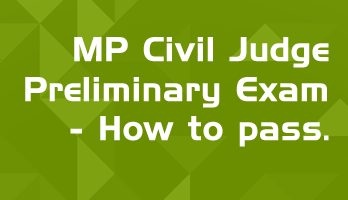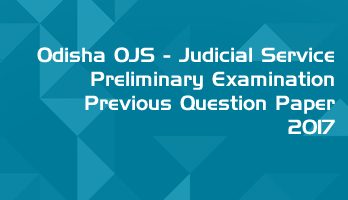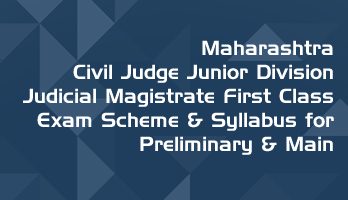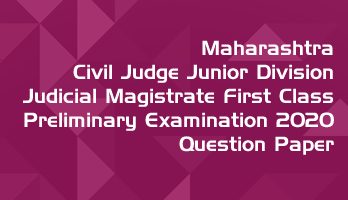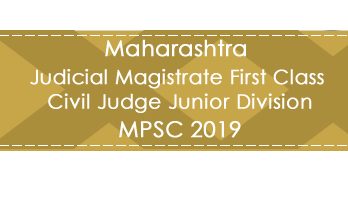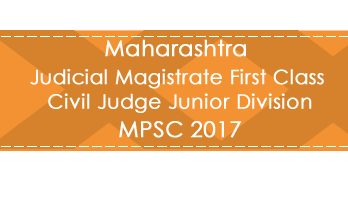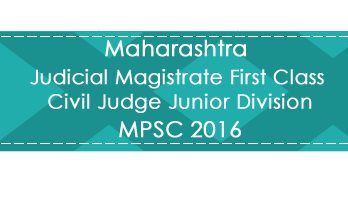Odisha OPSC OJS Judicial Prelims 2026 and 2027 - 155 Mock Tests & Previous Question Papers
- 100 Full Length Mock Tests - with unlimited practice
- 55 Topic wise Mock Tests covering all the topics in the syllabus
- Previous Question Papers - with official answer keys
- Downloadable PDF copies of all bare acts as per syllabus
- Database of over 15000+ MCQs
- Mock Tests designed as per latest syllabus and pattern
- Access valid for one year from date of purchase
- Questions & Answer Choices randomly shuffled in every attempt for better practice
- Accessible 24 x 7 via Smart-Phone browsers, Laptops, Desktops and Tablets
- This question paper, with official answer key is available on our Odisha OJS Preliminary Online Mock Test & Previous Question Papers Series.
- Unlimited access for one year from the date of purchase
- Mock tests are updated as per the latest pattern and syllabus
- See the links at the top to buy the online Odisha OJS Judicial mock tests
1. Under the Indian Penal Code, abetment is constituted
(a) by instigating a person to commit an offence
(b) by engaging in a conspiracy to commit an offence
(c) by intentionally aiding a person to commit an offence
(d) All of the choices
2. The distinction between Sections 299 and 300 IPC was made clear by
(a) Marshall, J in R v. Govinda
(b) Melvill, J in Govinda v. R
(c) Melvill, J in R v. Govinda
(d) Marshall, J in Govinda v. R
3. Which Section deals with dowry death?
(a) 304A of IPC
(b) 498A of IPC
(c) 489A of IPC
(d) 304B of IPC
4. Grievous Hurt means
(a) emasculation
(b) disfiguration
(c) any hurt which endangers life
(d) All of the choices
5. Whoever voluntarily obstructs any person so as to prevent that person from proceeding in any direction in which that person has a right to proceed is
(a) wrongful confinement
(b) force
(c) wrongful restraint
(d) defamation
6. Whoever by force compels or by any deceitful means induces any person to go from any place is
(a) abduction
(b) kidnapping
(c) slavery
(d) forced labour
7. The solemn resolution in the Preamble of our Constitution is made in the name of
(a) Constituent Assembly of Free India
(b) Constitution of India
(c) Indian Independence Act
(d) People of India
8. One of the remedies for false imprisonment is
(a) Habeas corpus
(b) Mandamus
(c) Certiorari
(d) Prohibition
9. Every citizen of India has a right to contest in election unless disqualified is
(a) an ordinary civil right
(b) an important constitutional right
(c) a fundamental right
(d) a fundamental duty
10. Article 39A of the Constitution of India deals with
(a) free legal aid
(b) free and compulsory education
(c) free housing to the poor
(d) free medical aid to the citizen
11. The members of the UPSC are appointed by
(a) the cabinet
(b) the chief justice of India
(c) the Prime Minister of India
(d) The President of India
12. Which one of the following amendment accorded procedure to Directive Principle over Fundamental Rights?
(a) 44th Amendment
(b) 24th Amendment
(c) 39th Amendment
(d) 42nd Amendment
13. The oath is administered to the President of India by:
(a) Speaker of the Lok Sabha
(b) Prime Minister of India
(c) Attorney General of India
(d) Chief Justice of India
14. The special provisions to Finance Bills is provided under the Constitution of India
(a) Article 114
(b) Article 115
(c) Article 116
(d) Article 117
15. Suspension of provisions of Article 19 during Emergency is dealt in
(a) Article 352
(b) Article 355
(c) Article 358
(d) Article 361
16. Provisions as to the administration and control of Scheduled Areas and Scheduled Tribes are in
(a) Ninth Schedule
(b) Seventh Schedule
(c) Fifth Schedule
(d) Third Schedule
17. Section 89 of the CPC was inserted in
(a) 1993
(b) 1998
(c) 1999
(d) 2009
18. For instituting a suit against the government, notice should be given before
(a) two months
(b) three months
(c) one month
(d) six months
19. Decision on question of limitation
(a) operates as res judicata
(b) does not operate as res judicata
(c) operates as res judicata, if not erroneous
(d) None of the choices
20. The Code of Civil Procedure
(a) applies to the whole of India except Jammu and Kashmir
(b) applies to the whole of India
(c) applies to the whole of India except Jammu and Kashmir and Nagaland
(d) applies to the whole of India except Jammu and Kashmir, Nagaland and Tribal Areas
21. Choose the most appropriate answer: A judgment debtor
(a) cannot be arrested
(b) can be arrested
(c) can be arrested and detained if certain conditions are fulfilled
(d) can be arrested and detained if certain conditions are fulfilled only in civil prison
22. Choose the most appropriate answer: Movable property not in possession of the judgment debtor
(a) cannot be attached
(b) can be attached by actual seizure
(c) can be attached by an order prohibiting the person in possession thereof from giving it to the judgment debtor
(d) by leaving the same in the custody of respectable person as custodian
23. Precept means
(a) command
(b) order
(c) writ
(d) All of the choices
24. Garnishee means
(a) Judgment debtor
(b) Judgment creditor
(c) Judgment debtor’s debtor
(d) Guarantor
25. Suo Motu means
(a) in the matter
(b) suit filed
(c) of its own motion
(d) small matter
26. ‘Actus curiae neminem gravabit’ means:
(a) The act of court shall harm no one
(b) Grave acts cannot be pardoned
(c) Remedy must cure the act
(d) All acts cannot be sued in a court
27. Section 75 of the Indian Evidence Act, 1872 deals with
(a) public documents
(b) private documents
(c) certified copies of public documents
(d) proof of other official documents
28. The term admission is defined in the Indian Evidence Act, 1872 in
(a) Section 17
(b) Section 18
(c) Section 19
(d) Section 20
29. Section 23 of the Indian Evidence Act, 1872 deals with
(a) relevance of admissions in civil cases
(b) relevance of oral admissions as to contents of documents
(c) relevance of oral admissions as to contents of electronic documents
(d) None of the choices
30. According to Section 141 of the Indian Evidence Act, 1872, any question suggesting the answer which the person putting it wishes or expects to receive, is called a
(a) answerable question
(b) convenient question
(c) suggestive question
(d) leading question
31. The term ‘Examination-in-chief’ has been defined in the Indian Evidence Act, 1872 in
(a) Section 137
(b) Section 138
(c) Section 139
(d) Section 140
32. The examination of a witness by the adverse party shall be called his
(a) examination-in-chief
(b) cross examination
(c) re-examination
(d) examination on facts
33. Section 115 of the Indian Evidence Act, 1872 deals with
(a) estoppel
(b) estoppel of tenant
(c) estoppel of acceptor of bill of exchange, bailee or licensee
(d) evidence as to affairs of state
34. A witness who is unable to speak is called as
(a) deaf witness
(b) dumb witness
(c) hostile witness
(d) unreliable witness
35. ‘Actus me invito tactus non est mens actus’ means
(a) the act itself does, not make a man guilty unless his intentions were so
(b) an act done by me against my will is not my act at all
(c) the intent and the act both must concur to constitute crime
(d) None of the choices.
36. Robbery is an aggravated form of
(a) theft
(b) extortion
(c) both theft and extortion
(d) All of the choices
37. Person who may be said to be of unsound minds
(a) an idiot
(b) a madman
(c) one who is drunk
(d) All of the choices
38. When two or more persons by fighting in a public place disturb the public peace is
(a) affray
(b) riot
(c) assault
(d) curfew
39. The Court of a Magistrate of first class may pass a sentence of imprisonment for a term not exceeding
(a) three years
(b) five years
(c) seven years
(d) four years
40. Under which Section of Cr.P.C. a police officer can arrest a person without an order from a Magistrate and without warrant?
(a) Section 42
(b) Section 40
(c) Section 51
(d) Section 41
41. Power to search a place is provided under
(a) Section 45
(b) Section 46
(c) Section 47
(d) Section 48
42. Which of the following is process to compel the appearance of persons before the criminal courts?
(a) summons
(b) warrants
(c) attachment and sale of property
(d) All of the choices
43. Under which Section of Cr.P.C. a person who is avoiding execution of a warrant may be proclaimed absconder?
(a) Section 81
(b) Section 83
(c) Section 82
(d) Section 84
44. Any dispute relating to possession of Immovable property is decided by
(a) Judicial Magistrate
(b) Executive Magistrate
(c) Either by Executive Magistrate or by Judicial Magistrate
(d) Neither by Executive Magistrate nor by Judicial Magistrate
45. The recording of the statements by a police officer during investigation is provided by
(a) Section 161(1)
(b) Section 161(2)
(c) Section 161(3)
(d) Section 162(1)
46. Under Section 167, the Magistrate can order detention in
(a) police custody
(b) judicial custody
(c) jail
(d) any custody as he thinks fit
47. Which of the following Sections does not provide for joinder of charges?
(a) Section 219
(b) Section 221
(c) Section 222
(d) Section 225
48. Which Section is based on the maxim ‘Nemo debet bis vexari prop eadem cause’ i.e. a man shall not be twice vexed for one and the same cause?
(a) Section 300
(b) Section 301
(c) Section 302
(d) Section 303
49. Chapter V of the Indian Evidence Act, 1872 deals with
(a) oral evidence
(b) documentary evidence
(c) burden of proof
(d) witnesses
50. Section 62 of the Indian Evidence-Act, 1872 deals with
(a) primary evidence
(b) secondary evidence
(c) proof of documents by primary evidence
(d) cases in which secondary evidence relating to documents may be given
Odisha OPSC OJS Judicial Prelims 2026 and 2027 - 155 Mock Tests & Previous Question Papers
- 100 Full Length Mock Tests - with unlimited practice
- 55 Topic wise Mock Tests covering all the topics in the syllabus
- Previous Question Papers - with official answer keys
- Downloadable PDF copies of all bare acts as per syllabus
- Database of over 15000+ MCQs
- Mock Tests designed as per latest syllabus and pattern
- Access valid for one year from date of purchase
- Questions & Answer Choices randomly shuffled in every attempt for better practice
- Accessible 24 x 7 via Smart-Phone browsers, Laptops, Desktops and Tablets
51. Which of the following is transferable property?
(a) actionable claim
(b) pension
(c) right of way
(d) change of legacy
52. Where mortgagee is entitled to enjoy the benefits of the mortgaged property in lieu of interest on debt, the mortgage is called
(a) simple mortgage
(b) equitable mortgage
(c) usufructuary mortgage
(d) English mortgage
53. Which of the following in not a duty of the seller?
(a) to produce title deeds
(b) to disclose patent defects
(c) to execute conveyance
(d) to pay the outgoings
54. Consideration for lease is
(a) license
(b) price
(c) debt
(d) premium
55. A person who projects himself to be owner when he is not is called
(a) ostensible owner
(b) co-owner
(c) equitable owner
(d) None of the choices
56. Section 14 of the T.P. Act deals with
(a) conditional transfer
(b) vested interest
(c) rule against perpetuity
(d) restricted covenant
57. The period of limitation for filing of a suit on the basis of promissory note from the date of its execution is
(a) one year
(b) two years
(c) three years
(d) six years
58. The limitation period in a suit by a surety against a co-surety when the surety pays anything in excess of his own share is
(a) one year
(b) three years
(c) six years
(d) twelve years
59. What is the limitation period in a suit by a landlord to recover possession from a tenant after the date the tenancy is determined?
(a) one year
(b) three years
(c) six years
(d) twelve years
60. For a review of judgment by a Court other than the Supreme Court, from the date of decree or order, the limitation is
(a) thirty days
(b) three years
(c) six years
(d) twelve years
61. In computing the period of limitation for an appeal, a review or revision, the time requisite for obtaining a copy of the decree or the order appealed against shall be excluded under
(a) Section 11(a)
(b) Section 12(2)
(c) Section 13(3)
(d) Section 14(4)
62. ‘Time requisite’ under Section 12(2) of the Limitation Act means
(a) absolutely necessary time
(b) actual time taken
(c) maximum time
(d) minimum time
63. Section 17 of the Limitation Act takes within its ambit
(a) concealments
(b) frauds
(c) mistakes
(d) All of the choices
64. Section 17 of the Limitation Act does not take within its ambit
(a) an appeal
(b) an execution application
(c) a suit
(d) All of the choices
65. The period of limitation for setting aside a sale on execution of a decree is
(a) 30 days
(b) 60 days
(c) 90 days
(d) 180 days
66. Which of the following amount to presenting civil proceedings with ‘due diligence and in good faith’ within the meaning of Section 14 Of the Limitation Act?<br>(a) failure to pay the requisite court fee found deficient<br>(b) error of judgment in valuing a suit
(a) (a) only
(b) (b) only
(c) both (a) and b)
(d) neither (a) nor (b)
67. In which of the following cases the Court by going negatively with women’s right to property, disqualified the daughter-in-law’s right to father-in-law’s property on the ground that the son had murdered his own father?
(a) Vallikannu v. R. Sengaperumal, AIR 2005
(b) Narashimha Murthy v. Sushilabai, AIR 1996
(c) Gurupad v. Heerabai, AIR 1978
(d) Shyama Devi v. Manju Shukla (1994)
68. Presumption that the younger survived the elder under Section 21 of the Hindu Succession Act, 1956 is a
(a) presumption of fact
(b) presumption of fact and law
(c) rebuttable presumption of law
(d) irrebuttable presumption of law
69. Which Section of the following of the Indian Succession Act, 1925 treats agnates and cognates and male and female heirs equally?
(a) Section 27(a)
(b) Section 27(b)
(c) Section 33A
(d) Section 26
70. ‘A’ who is governed by Indian Succession Act, executes an instrument purporting to his will, but he does not understand the nature of the instrument, nor the effect of its provision. This instrument is
(a) valid
(b) invalid
(c) voidable
(d) None of the choices
71. In which Section of the following of the Indian Succession Act, 1925 it is provided that where a bequest is made to a person by a particular description, and there is no person in existence at the testator’s death who answers the description, the bequest is void under
(a) Section 111
(b) Section 112
(c) Section 114
(d) Section 116
72. ‘A’ by his will, bequeaths to ‘B’ the sum of Rs. 5,000 and afterwards in the same will repeats the bequest in the same words. ‘B’ is entitled to
(a) one legacy of Rs. 5,000
(b) both legacy of Rs. 5,000
(c) legacy becomes invalid
(d) None of the choices
73. Schedule V of the Indian Succession Act, 1925 deals with
(a) form of certificate
(b) form of caveat
(c) form of probate
(d) form of letters of administration
74. Section 14 of the Hindu Succession Act, 1956 applies to
(a) movable property
(b) immovable property
(c) both movable and immovable property
(d) None of the choices
75. A suit of Possession under Section 5 of the Specific Relief Act, can be filed within
(a) 3 years
(b) 6 years
(c) 9 years
(d) 12 years
76. Under the Specific Relief Act, a suit for Recovery of Possession can be filed
(a) only in respect of movable property
(b) only in respect to immovable property
(c) in respect of movable or immovable property
(d) None of the choices
77. Section 26 of the Specific Relief Act fixes the time limit for discovery of mistake or fraud to be
(a) six months
(b) three months
(c) one year
(d) None of the choices
78. A claim for damages in a suit for injunction can be laid down
(a) under Section 38 of the Specific Relief Act’
(b) under Section 39 of the Specific Relief Act
(c) under Section 40 of the Specific Relief Act
(d) under Section 37 of the Specific Relief Act
79. Section 11 of the Specific Relief Act, 1930 provides for
(a) specific performance of a part of the contract
(b) defence respecting suits for relief based on contract
(c) specific performance of contracts connected with trusts
(d) circumstances in which specific performance of a contract is enforceable
80. Obligation under Specific Relief Act
(a) is a right in rem
(b) is a right in personam
(c) is a right in rem and in personam
(d) None of the choices
81. Under the Specific Relief Act, the declaratory decree can
(a) be declined
(b) not be declined
(c) be commuted
(d) be withheld
82. Under Section 12(2) of the Specific Relief Act, 1963 part performance of a Contract can be enforced by
(a) the promisor
(b) the promisee
(c) both promisor and promisee
(d) None of the choices
83. Section 8 of the Specific Relief Act can be invoked
(a) against a person who has possession or control over the property
(b) against the person who is the owner of the article claimed
(c) by the person not entitled to the possession of the article
(d) in respect of the ordinary article
84. In a suit under 6 of the Specific Relief Act, the Court can
(a) adjudicate on the title
(b) direct the defendant(s) to remove the structure
(c) permit the plaintiff to pull down the structure
(d) None of the choices
85. The term ‘donation mortis causa’ refers to
(a) death bed gift
(b) actionable claims
(c) universal donee
(d) None of the choices
86. Right of redemption arises in the case of
(a) gifts
(b) mortgage
(c) lease
(d) exchange
87. Which of the following is a doctrine of equity?
(a) doctrine of redemption
(b) doctrine of consolidation
(c) doctrine of lis pendens
(d) doctrine of marshalling
88. Which of the following deals with the doctrine of election?
(a) Section 45
(b) Section 15
(c) Section 53A
(d) Section 35
89. To convert a proposal into a promise, the acceptance must be
(a) absolute and qualified
(b) absolute and unqualified
(c) unusual and reasonable
(d) usual and qualified
90. Contracts of Adhesion are
(a) unfair contracts
(b) unlawful contracts
(c) contracts of adults
(d) standard form contracts
91. A agrees with B to discover treasure by magic. The agreement is
(a) void
(b) voidable
(c) illegal
(d) unnatural
92. If the goods are bailed for hire, the bailor is responsible for damages for the faults in the bailed goods which
(a) he is aware
(b) he is not aware
(c) he is aware and unaware
(d) he is reasonably aware
93. A contract of guarantee may be
(a) oral
(b) written
(c) oral or written
(d) None of the choices
94. If the promisor absolutely repudiates the contract prior to the promised date of performance, it is
(a) frustration
(b) impossibility of performance
(c) final breach
(d) anticipatory breach
95. If a person is employed by and acting under the control of the original agent in the business of agency, he is known as
(a) sub-agent
(b) substituted agent
(c) del-credere agent
(d) mercantile agents
96. A contract to pay B, Rs. 20,000 if B’s house is burnt, it is a
(a) wagering contract
(b) quasi contract
(c) contingent contract
(d) illegal contract
97. To create an agency
(a) consideration in necessary
(b) consideration is not necessary
(c) some consideration is necessary
(d) adequate consideration is necessary
98. Every agreement, of which the object or consideration is unlawful, is
(a) void
(b) voidable
(c) illegal
(d) unfair
99. ‘Heir’ has been defined under
(a) Section 3(d) of the Hindu Succession Act
(b) Section 3(e) of the Hindu Succession Act
(c) Section 3(f) of the Hindu Succession Act
(d) Section 3(g) of the Hindu Succession Act
100. Hindu Succession Amendment Act, 2005 came into effect on
(a) 9th June, 2005
(b) 9th August, 2005
(c) 9th July, 2005
(d) 9th September, 2005
- This question paper, with official answer key is available on our Odisha OJS Preliminary Online Mock Test & Previous Question Papers Series.
- Unlimited access for one year from the date of purchase
- Mock tests are updated as per the latest pattern and syllabus
- See the links below to buy the online Odisha OJS Judicial mock tests
Odisha OPSC OJS Judicial Prelims 2026 and 2027 - 155 Mock Tests & Previous Question Papers
- 100 Full Length Mock Tests - with unlimited practice
- 55 Topic wise Mock Tests covering all the topics in the syllabus
- Previous Question Papers - with official answer keys
- Downloadable PDF copies of all bare acts as per syllabus
- Database of over 15000+ MCQs
- Mock Tests designed as per latest syllabus and pattern
- Access valid for one year from date of purchase
- Questions & Answer Choices randomly shuffled in every attempt for better practice
- Accessible 24 x 7 via Smart-Phone browsers, Laptops, Desktops and Tablets


